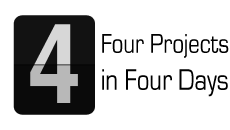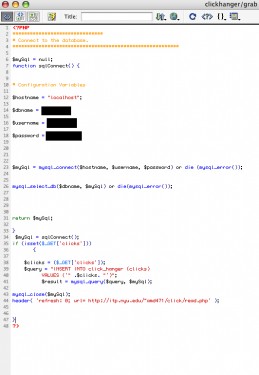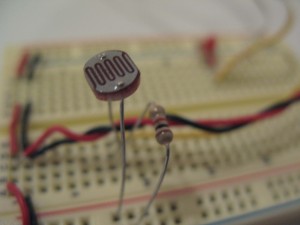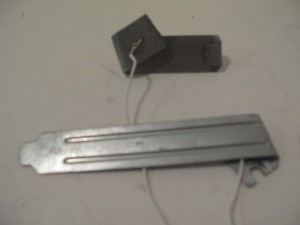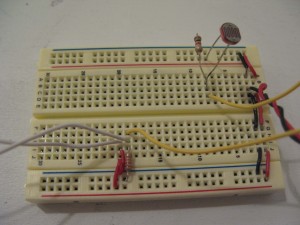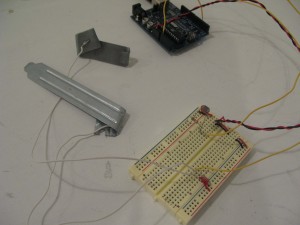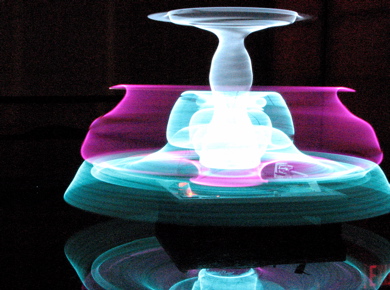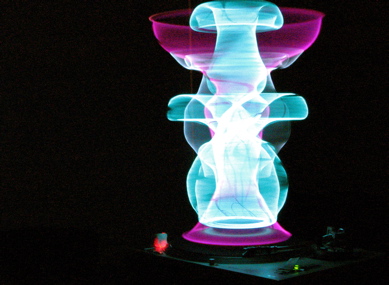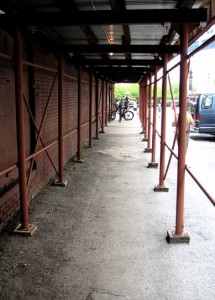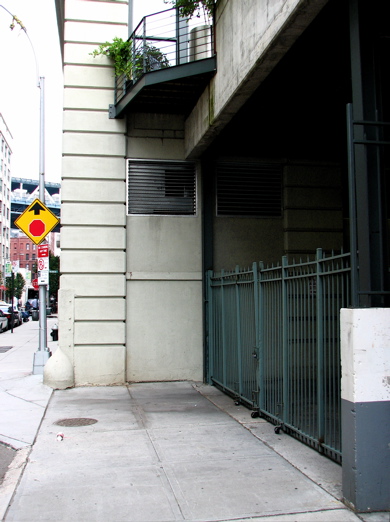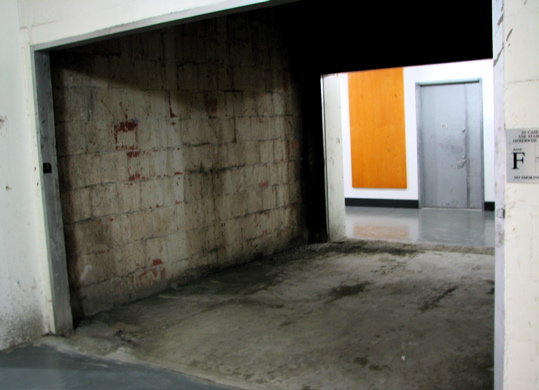Do a creative project every day for four straight days.
Projects must be completed in a day, so they need to be as compact as they are creative
Each project needs a name and documentation posted by the end of the day. Each should be a stand-alone accomplishment
crocheted plastic bag skirt
By Kristin O'Friel on August 2008, Day 3
the waste of the skirt is crocheted out of recycled plastic grocery bag strips and the skirt length out of inflated plastic bags.
more 5-in-5 photos on flickr
Add comment | August 1st, 2008
The Ultimate Personality Test, Click Hanger, Is Here!
By Andrea Dulko on August 2008, Day 3
Do you want Humphrey to succeed, or would you rather see him plummet. It’s up to you. With Click Hangers everyone works together to feed the hiker trail-mix from the blue square. To do this simply click once for each nut or raisin you’d like to feed him. Check his progress my clicking the corresponding button, but don’t click avalanche or you’ll ruin it for everyone!
In a previous post, I described how this idea stemmed from a desire to make people aware of how many times they click their mouse each day. Invisibly tracking mouse events on a Mac proved more difficult than anticipated. As an alternative, Josh and I used a embedded Processing app to simulate the effect in a localized area.
For each click, Processing sends a “1″ to grab.php:
grab.php inserts the 1′s into the click_hanger table.
Another file, read.php, takes the SUM of clicks and displays the hiker position accordingly.
Check out what Joshua has to say.
That’s all! Thanks.
3 comments | August 1st, 2008
Click Hanger
By Joshua Berry on August 2008, Day 3
Andrea and I built a little game based the Price is Right’s Cliff Hanger. The original intent was to pay homage to the absurd amount of mouse clicks we all must make in a single day by sending the ol’ mountain climber up the hill. I spent much of day 3 researching open source options for logging mouse clicks from Windows. Since every option I found was written in C, I began what I soon discovered was the daunting task of installing C compilers and debuggers without any knowledge whatsoever of C. There was some problem with the debugger installation that I could not overcome in one day, and my code would not compile, so we decided to drop that piece of the project for the time being and simulate it with a Processing application. The processing application stores into mySQL a value every time the mouse is clicked.
What began as more of a comment on our aggressive use of computers has turned into a game. The mountain climber moves up the mountain with each click on the blue square. Other users can sabotage the mountain climber by causing an avalanche. Try it, it’s fun!
1 comment | August 1st, 2008
Is My Roommate Home?
By Joshua Berry on August 2008, Day 2
Better late than never is my post about Day 2′s project! Sometimes you just want to be alone. If you’re already out and you knew your roommate would be in your apartment, you may decide to stay out. Likewise if you knew your roommate was gone, you might decide to stay in and relax while watching your shows. The solution is “Is My Roommate Home?” This device will *eventually* email, text, or call you with rommate status. Hardware issues prevented me from actually hooking this up to the Internet, but in the spirit of completing one project in one day, I’m happy with the progress. Main parts include a photocell, digital switch, and of course, and Arduino. See below for explanation.
A photocell (or ideally an IR sensor, which I could not obtain on short notice) attached to the ceiling inside your apartment, several feet from your front door, recognizes a change in light. This means that your roommate is inside your apartment and is either on his/her way out or his/her way in. The second piece is below.
This simple digital switch is made of scrap metal. One piece is attached to the door and the other to the threshold. When the door is closed the switch is on, and when the door is open the switch is off. If the photocell reading occurs before the switch opens, your roommate has left the apartment. If the switch opens before the photocell reading, your roommate has arrived. In each case you will be notified by either SMS/phone/email.
Here are photos of the breadboard and a bird’s eye view of the entire uninstalled device. The device is missing an XPort to connect this to the Internet. Luckily I have the code for this, so I plan to wrap this up next week after 5in5 is over.
Add comment | August 1st, 2008
DIY Audiobook
By Vikram Tank on August 2008, Day 3
For today’s project i recorded an audio book. I love listening to children’s stories on audio book, and thought it would be fun to make one on my own. I recorded Beverly Cleary’s Otis Spofford. It was actually one fo the more difficult projects I’ve done. I realized that spending 7 hours in a 2 by 3 foot padded room reading into a microphone is hard work. I did enjoy it though and the final file is below as well as a link to the Google books page.
1 comment | July 31st, 2008
Brady Bunch PhotoBooth
By Christian Bovine on August 2008, Day 3
Using an idea my friend Rob had to use processing to recreate the opening sequence to the Brady Bunch by recording a few seconds of you looking around then placing them in the appropriate squares. I collaborated with Ben Chao who is currently in LA who helped write the code.
Add comment | July 31st, 2008
Throwing Light
By Christian Cerrito on August 2008, Day 3
EL wire + Armature Wire + Solder + Clear Heat Shrink + Turntable + Inverter + Batteries + Base Block + Hot Glue + Double Sided Sticky Tape + 45 RPM+ A Dark Room + A Long Exposure = Sculpting light in the same manner that a potter throws clay on a wheel.
More to come….
3 comments | July 31st, 2008
Location Scouting for Art Under the Bridge
By Christian Cerrito on August 2008, Day 2
So, I’m a bit late in posting, and I have to apologize for that. Unfortunately, at around four in the morning last night, I realized that my second 5-in-5 project was getting completely out of hand, possibly better suited for a weeks worth of experimentation and building then a day. I may try and simplify and rebuild for Friday, we’ll see.
Anyway, yesterday morning/afternoon I had another project to deal with, location scouting. I’m lucky enough to have a small installation in the Art Under the Bridge Festival in DUMBO (Down Under the Manhattan Bridge Overpass), Brooklyn, and yesterday the folks at the DUMBO Arts Commission asked me to come down and meet with them. I’m incredibly excited to be a part of this, and pretty nervous at the same time. I’m calling the project “Stories from Things Left Behind,” an extension of one of the very first p-comp project I ever worked on (“Trash Talk” with Dave Overholt and EJ Park).
“Stories From Things Left Behind” is about a series of discarded objects: a shipping crate, a few kids’ lunch boxes, a briefcase, a steamer trunk, and a record case, all abandoned in a trash heap. The objects themselves will be outfitted with carefully hidden Arduinos, motors, speakers, and small LED lighting systems, enabling them the tell their “stories”. Inside the briefcase, for instance, it will sound as though a tiny board meeting is taking place, inside the lunch boxes, the sounds of kids laughing, the record crate, a 70′s disco party, etc. The objects, rejected and discarded, are understandably bitter; though they are more then happy to talk to one another, when a person comes to close (within 5-6 feet) they immediately clam up and shut their lids.
In order to make this all work, choosing the proper location is important. I need somewhere visible, yet slightly out of the way, so as to make the discovery of these pieces a surprise. The festival goes on for three days, and a lot of it is outside, meaning that dealing with rain is always a possibility. In order to determine when someone has wandered into the scene, I’ll be using ultra-sonic proximity sensors, which don’t do well in crowded spaces. Also, in order to use as few of these sensors as possible (I’m hoping to get away with just two for the whole thing), I need the space to be in a corner of sorts, so I can position the beams properly. All in all this is quite a bit to consider.
The DAC does an amazing job of working with local property management companies, business, and the city to allow artists to put their work in a variety of sites in the DUMBO area. This is amazingly accommodating, even maybe a little too much; I expected to be given just a few options, to make a quick decision, and then to be on my way. Instead, I spent six hours wandering around DUMBO, taking some snapshots, and weighing options.
Here are some of the spots I’m considering. I know that they look like nothing now, but come Sept. 26th, with a lot of luck, I should have everything up and running.
All in all, this wasn’t really how I planned on spending my day (my living room is covered in red fabric as a testament to this), but this was a project in and of itself, and I’m glad I got it done.
Add comment | July 31st, 2008
Dennis and Christian’s Project
By Dennis Crowley on August 2008, Day 4, Guest Star

Dennis Crowley and [Christian Bovine] spent all day doing 5 different Olympic Events: 100m freestyle, 100m dash, 110m hurdles, long jump and the rings (in gymnastics) and compared ourselves to Olympic athletes. This was to see just how amazing these athletes are in comparison to average Joe’s like Dennis and [Christian] and as an excuse to do Olympic events all day. Since we only had one day to do all the events with Robert Moon video taping us and then edit all the footage it could have been done a bit better but I think we are all happy with the outcome.
From Robert Moon’s Perspective:
I worked with Christian Bovine and Dennis Crowley for our Day 2 project: Average Athlete versus Olympic Athlete. My day started bright and early at 6 am so I make it on time to meet the two average athletes at the public pool on the corner of Pitt and Houston. We were quite lucky that the pool supervisor let us shoot that day for the 100 meter freestyle. For our next events, we shot the track and field events at the East River Park and ran into camp councilors who helped us properly set up the hurdles and long jump events. And for our final rings event was held at the Neistat Brothers studio where they have a set of rings set up for doing the “muscle up.”
As the person behind the camera, I wanted to match the camera angles with the Olympic trials footage we used for this project. Christian and I edited throughout the evening and set it to render over night. You can check out the video below.
Special thanks to our track & field experts:
Nandi Dozier-Lewis, Andrew Olsen and Stephanie Velez
And our rings expert:
Van Neistat
Add comment | July 31st, 2008
Floor Plan
By Tim Szetela on August 2008, Day 3
I’ve spent so much time here at ITP (especially this week) that I’ve wondered how it has changed through the years. With the help of people that have seen some of the construction and alterations made to the fourth floor, I gathered floor plans from the last ten years. For the Wednesday project, using Flash, I redrew them all and created an interactive floor plan so that people could see how the interior space has changed (through demolished and rebuilt walls and continued reassignment of various spaces). I also wanted to look at the floor plan a bit differently, so I created a map of the actual floor (the carpet, tiles, wood). The link to Floor Plan is below (click on the wood square to see the floor textures). The image below is of Floor Plan on a monitor near ITP’s equipment room (visible on the map).

1 comment | July 31st, 2008
The Peggy Lite-Brite
By Corey Menscher on August 2008, Day 3
1502 solder points. ~7.5 meters of solder. 7 hours. 1 peggy. This is the Peggy Lite-Brite…

I’ve owned a Peggy 1.0 for several months now, but never assembled it. Ever since I got it, I’ve wanted to solder female headers to it so that I could re-use it indefinitely. But the idea of soldering 625 headers to all available pixels, as well as the other necessary componenets, was daunting. Fortunately, 5in5 gave me the opportunity to realize my dream. I got to work at 11:30am, and finished soldering the last component at 6:35pm. (I did take about 20 minutes to each lunch.) I’m extremely happy with the outcome! I know the Peggy has been called an “adult Lite-Brite” for a while now, but until now no Peggy has ACTUALLY become an adult Lite-Brite…as far as I know.
(more…)
4 comments | July 31st, 2008
Subwoofer Tactics
By C. Anderson Miller on August 2008, Day 3
Adam Parrish and I designed and built a game in which players use a subwoofer and 3 tones to manipulate pieces on a game board.

(more…)
Add comment | July 31st, 2008
The U Can’t Resistor Me Dress
By Armanda Lewis on August 2008, Day 3
For Day#3, I tried a wearable, and almost made it to completion. I hit a snag at the very end when my Lilypad Arduino would not upload. I am going to continue debugging to try and figure out why it will not upload programs. I began by selecting a pattern and cutting it out and sewing it up. http://itp.nyu.edu/blogs/al861/files/pattern.thumbnail.jpg” alt=”pattern.jpg
Then I worked on the circuitry, which was just a few purple leds which will light up the darker the environment gets. Everything worked great on the breadboard, but I could never get the Lilypad to upload (I consistently got an “initialization error”).
Here are some pictures of the finished dress before the circuitry was added, and details of the collar region with circuitry:
http://itp.nyu.edu/blogs/al861/files/dress.thumbnail.jpg
In these two pictures, you can see the green USB component to upload programs to the Lilypad. Unfortunately, this is where I hit a snag.
http://itp.nyu.edu/blogs/al861/files/collar_front.thumbnail.jpg” alt=”collar_front.jpg (front side of collar region-the collar is adorned with rhinestones, leds and a Lilypad Arduino) http://itp.nyu.edu/blogs/al861/files/collar_back.thumbnail.jpg (underside of collar region)
I will update this post when I get the Lilypad uploading properly.
1 comment | July 31st, 2008
how to write a short short story over twitter
By John Dimatos on August 2008, Day 3
The idea of a serialized novel hit it’s peak in the Victorian Era, and has always been something that interested me, for the particular challenge it poses in terms of always keeping the reader at a heightened state of interest. With a normal end to end novel or story, authors can indulge themselves with lengthy imagery, character building, or in the case of David Foster Wallace hundreds of pages of footnotes. But besides creating unforgiving regular deadlines for writers (a surefire anathema amongst the more petulant of them), there was also the equally unforgiving quota of words, a yardstick by which writers to this day get paid.
The idea that Twitter and text messaging lends itself to a short form serialization of a story over a predetermined length of time is not a paradigm shattering idea; In Japan serialized novels via texting have been making the top 10 sales consistently for over a year now. My specific goal for this project was to create a platform that would allow me work within the twitter parameters in an automated fashion.
Imagine my surprise when I turned to Google spreadsheets to create that platform.
1 comment | July 31st, 2008
Etsy Street: Frankenface
By Bre Pettis on August 2008, Day 1, Guest Star
I was invited to participate for a day in the 5-in-5 Challenge, a competition to complete a creative project every day for five straight days. The 5-in-5 Challenge takes place at the Interactive Telecommunications Program, a Master’s program at New York University. If I could go back in time, I would be seriously tempted to try and get into this hands-on technology program. By the time students graduate, they have learned a lot about physical computing and can make pretty much anything they can imagine.
MP4 | Blip.tv | Youtube | iTunes
I also had the chance to interview Robert Moon about his ecofabulous wallet, Adam Parrish about his pixel linocuts, and Joshua Berry about his summer mittens. This is just a taste of the projects that are coming out of the 5-in-5 Challenge. To learn more and to watch the projects that emerge over the week, check out the 5-in-5 blog.
My guest Michael Zeltner of GRL Vienna and I worked on a Frankenface project to play with videos in the same way you can play with collages.
Etsy Street is a video series about things I see in the world and want to share with the Etsy community. Check out the first post here. Feel free to give me feedback and let me know what you think!
1 comment | July 31st, 2008
